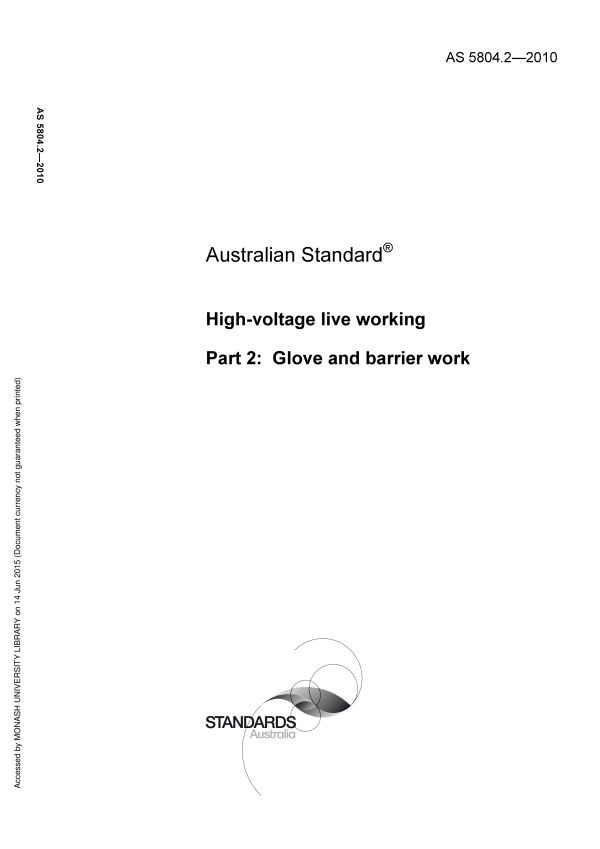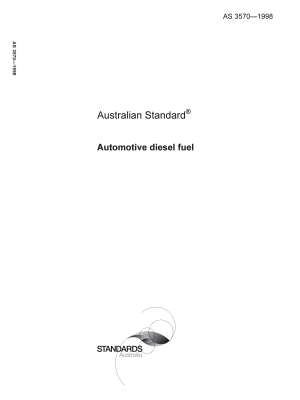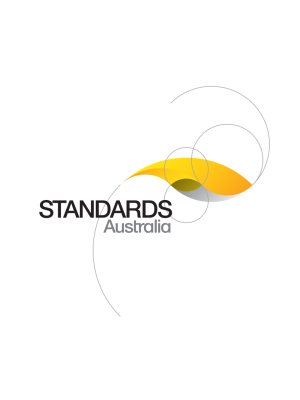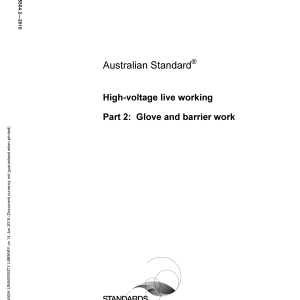🔍

Purchase the full subscription package now and enjoy a 40% discount, along with free updates for future editions.
AS 5804.2-2010
$119.21
High-voltage live working, Part 2: Glove and barrier work
Specifies requirements for live high-voltage glove and barrier work. It is intended for use with AS 5804.1.
Table of contents
Header
About this publication
Preface
1 Scope and general
1.1 Scope
1.2 Concept
1.3 Referenced and related documents
1.4 Definitions
2 Work practices
2.1 Minimum requirements for glove and barrier work
2.2 Work practices specific to glove and barrier work
2.2.1 Inspection and testing of gloves and sleeves prior to use
2.2.2 Wearing of insulating gloves and sleeves
2.2.3 Working from an insulating EWP
2.2.4 Inspection of insulating EWPs
2.2.5 Contact between the insulated boom or basket of an insulating EWP and uninsulated conductive or earthed objects
2.2.6 Direct connected hydraulic tooling
2.2.7 Working from an insulating platform or insulating positioning tower
2.2.8 Barrier insulation
2.2.9 Live work manual
2.2.10 Operation of switching devices
2.2.11 Maintenance of effective insulation
2.2.12 Making and breaking of electrical connections
2.2.13 Two levels of insulation
2.2.14 Transition between work methods
3 Combined live work methods
3.1 General
3.2 Combination of glove and barrier and stick methods
4 Live worker clearances
4.1 Minimum air insulation to uninsulated body
4.2 Other energized electrical apparatus
5 Equipment
5.1 Gloves and sleeves
5.1.1 General
5.1.2 Colour of insulating gloves and sleeves
5.1.3 Use of protective outer gloves
5.1.4 Use of inner gloves
5.1.5 Overlap of gloves and sleeves
5.2 Insulating barriers
5.2.1 General
5.2.2 Styles of insulating barriers
5.2.3 Use of insulating barriers on single wire earth return (SWER) systems
5.2.4 Temperature performance of insulating barriers
5.2.5 Installation of insulating barriers
5.3 Flexible barrier insulation
5.3.1 General
5.3.2 Rubber insulating blankets
5.3.3 Rubber insulating line hose
5.3.4 Rubber insulating covers
5.3.5 Insulation characteristics—Flexible barrier insulation
5.3.6 Voltage rating of flexible barrier insulation
5.3.7 Class of flexible insulation
5.4 Rigid barrier insulation
5.4.1 General
5.4.2 Classification
5.4.2.1 Types
5.4.2.2 Grades
5.4.2.3 Classes
5.4.3 Workmanship, finish and appearance
5.4.4 Marking
5.4.5 Testing
5.4.6 Insulation characteristics—Rigid barrier insulation
5.5 Voltage rating of rigid barrier insulation
5.6 Insulating elevating work platforms (EWPs)
5.6.1 Inspection and cleaning of insulating EWPs prior to use
5.6.2 Insulation of the basket of the insulating EWP
5.6.3 Tooling or other accessories
5.6.4 Work performed on an insulating EWP
5.6.5 Earthing and bonding of the chassis of the insulating EWP
5.6.6 EWP lanyards
5.7 Insulating platforms
5.7.1 General
5.7.2 Requirements for insulating platforms
5.8 Insulating positioning towers (IPT)
5.9 Insulated temporary jumpers
5.10 Live work sticks
5.11 Other equipment
6 Care and maintenance of equipment
6.1 Equipment cleaning and maintenance
6.1.1 Insulating gloves and sleeves
6.1.1.1 Cleaning
6.1.1.2 Testing and inspection
6.1.2 Storage of insulating gloves and sleeves
6.1.3 Repair of gloves and sleeves
6.1.4 Insulating barriers
6.1.4.1 Flexible barriers
6.1.4.2 Rigid insulating barriers
6.1.5 Storage of insulating barriers
6.1.6 Repair of insulating blankets
6.1.7 Insulating basket liner
6.1.8 Temporary insulated jumpers
6.1.9 Insulating EWP
6.1.10 Live work sticks
6.1.11 Insulated hydraulic tool hoses
6.1.11.1 Inspection and cleaning
6.1.11.2 Storage
6.1.11.3 Lanyards
6.2 Equipment electrical test
6.2.1 General
6.2.2 Lanyards
6.3 Periodic electrical testing intervals
Cited references in this standard
Please select a variation to view its description.
| Published | 09/08/2010 |
|---|---|
| Pages | 25 |
Please select a variation to view its pdf.



